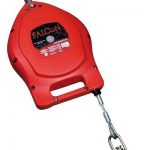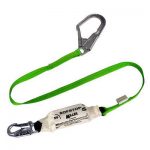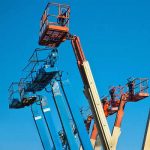Self-Retracting Lifelines Versus Shock-Absorbing Lanyards: Which Should You Use?
 When discussing the effectiveness of certain types of fall protection equipment, there is a debate going on these days over which type of connector is best: self-retracting lifelines (SRLs) or 6-foot shock absorbing lanyards (the connector is the device that links the body harness to an anchorage, such as an overhead fixed track or single-point anchor points). It is our opinion that SRLs are the best type of connector. Yes, lanyards are less expensive, but SRLs provide more effective fall protection, and are worth the extra money you spend.
When discussing the effectiveness of certain types of fall protection equipment, there is a debate going on these days over which type of connector is best: self-retracting lifelines (SRLs) or 6-foot shock absorbing lanyards (the connector is the device that links the body harness to an anchorage, such as an overhead fixed track or single-point anchor points). It is our opinion that SRLs are the best type of connector. Yes, lanyards are less expensive, but SRLs provide more effective fall protection, and are worth the extra money you spend.
Why SRLs Are More Effective Than Lanyards
The SRL is better from a fall protection standpoint because it results in a shorter free fall, while lanyards result in a much greater fall distance. The free-fall distance is directly related to the top descent speed the body reaches, which is directly related to the stopping forces on the body. Therefore, less is better.
SRLs come in lengths of up to 600 feet. They have a roller device inside that performs similar to a seat belt. It lets the lifeline play out to its maximum length as a user moves away from the anchor point, and automatically retracts as the worker backs up again. In the event of a sudden force, it immediately locks. With a lanyard, the user’s movement is limited to the length of the lanyard.
SRLs require a total fall clearance of only 6-1/2 feet, measurable from the surface where the worker works (as long as the SRL unit is located higher than the D-ring of the user’s body harness). This surface might be a floor or steel beam in a construction project, a loading dock, service platform, or the top of a vehicle, such as a rail car or bus.
If a worker falls, the SRL locks up quickly, and begins to arrest their descent within 8 to 9 inches. It then decelerates, lowering the maximum arresting force on the worker’s body to 900 lbs. The worker stops falling within (often before) 42 inches, or 3-1/2 feet. An additional 3 feet of space is required per OSHA regulations, for a total clearance of 6-1/2 feet. (3 + 3-1/2 = 6-1/2 feet).
Shock-Absorbing Lanyards Are Fixed-Length Lifelines
 On the other hand, lanyards require 18-1/2 feet of clearance, which must be measured from the anchorage connector to where the lanyard is tied off, not from the work surface. Lanyards are fixed-length lifelines, usually six feet long (before consideration of the shock pack). The lanyard includes a shock pack that is attached to the worker’s safety harness, usually at the shoulder.
On the other hand, lanyards require 18-1/2 feet of clearance, which must be measured from the anchorage connector to where the lanyard is tied off, not from the work surface. Lanyards are fixed-length lifelines, usually six feet long (before consideration of the shock pack). The lanyard includes a shock pack that is attached to the worker’s safety harness, usually at the shoulder.
If a worker falls, they must travel the full 6-foot length of the lanyard before the shock pack activates and begins to stop their momentum, plus an additional 3-1/2 feet of deceleration, for a total distance of 9-1/2 feet before consideration of the anchor point location. In measuring the necessary clearance, you need to include an additional 6 feet for the worker’s height, and per OSHA, a 3-foot safety factor underneath the worker, for a total required clearance of 18-1/2 feet. (6 + 3-1/2 + 6 + 3 = 18-1/2 feet). A six-foot lanyard connected to an point at the level of the worker’s feet can result in a free fall of twelve feet (6′ worker height plus 6′ lanyard length).
OSHA Requires A Fall Protection Rescue Plan
OSHA regulations require that you have a rescue plan in place. If the employee falls, they must either be able to self-rescue, or the employer must be able to perform a prompt rescue. Since fall distances for an SRL are shorter, an employee using an SRL often has the ability to self-rescue, whereas, an employee using a lanyard often does not have this ability.
Using SRLs in Work Environments With A Low Fall Clearance
SRLs are extremely effective in elevated areas with a low fall clearance. Proper fall arrest protection must be able to stop the user’s descent before they impact, so SRLs are ideal for places where the employee is working in a low fall clearance area and needs mobility to move around.
SRLs are best used in industrial settings, where overhead horizontal lifelines are installed, such as fixed-track lifelines. These types of facilities might include factories and manufacturing plants, distribution centers, aviation-related maintenance, such as in aircraft service hangars, public transportation maintenance facilities (for buses or light rail trains), rail yards, or loading docks and service areas for trucks or railcars.
Using SRLs in a Boom Lift
 Another situation where an SRL is the ideal fall protection system is when the user is in the basket of a boom lift (see picture). Boom lifts are used in a variety of situations including telephone and electrical wire maintenance, infrastructure and highway construction and maintenance, tree trimming, window washing, outdoor cleaning and painting, and airport and aircraft maintenance.
Another situation where an SRL is the ideal fall protection system is when the user is in the basket of a boom lift (see picture). Boom lifts are used in a variety of situations including telephone and electrical wire maintenance, infrastructure and highway construction and maintenance, tree trimming, window washing, outdoor cleaning and painting, and airport and aircraft maintenance.
If the driver of a boom lift goes over a bump or divot in the road, or takes a sudden curve, there will be a reaction in the extended boom. The basket will bounce, and a worker can be ejected if they don’t see it coming. If the worker is wearing an SRL that is anchored to the basket itself, the SRL will sense the sudden acceleration in motion. It will lock up and prevent the worker from being ejected.
On the other hand, if the user is wearing a six-foot lanyard, it will not stop them from being ejected from the basket. They might end up dangling in the air outside the basket, or worse, impacting the ground because the basket was not elevated high enough to provide the necessary clearance.
The Bottom Line: SRLs Shorten The Fall Distance
Some companies say lanyards are better used in construction situations where you have a higher fall tolerance. In our way of thinking, however, the SRL is the better option for all environments and fall protection systems, because it shortens the length of the fall and lessens the resulting maximum descent speed. It is less stressful to free-fall 9 inches (reaching a top speed of less than 5 mph) than to free-fall 12 feet (reaching a speed of approximately 19 mph). If you ask most people who use lifeline systems, they would probably tell you that they prefer to use an SRL over a lanyard. If you have questions about this topic and or would like to speak with one of our experts, give us a call. They will be glad to help.
or
dial us at 1-(855) 279-2000

